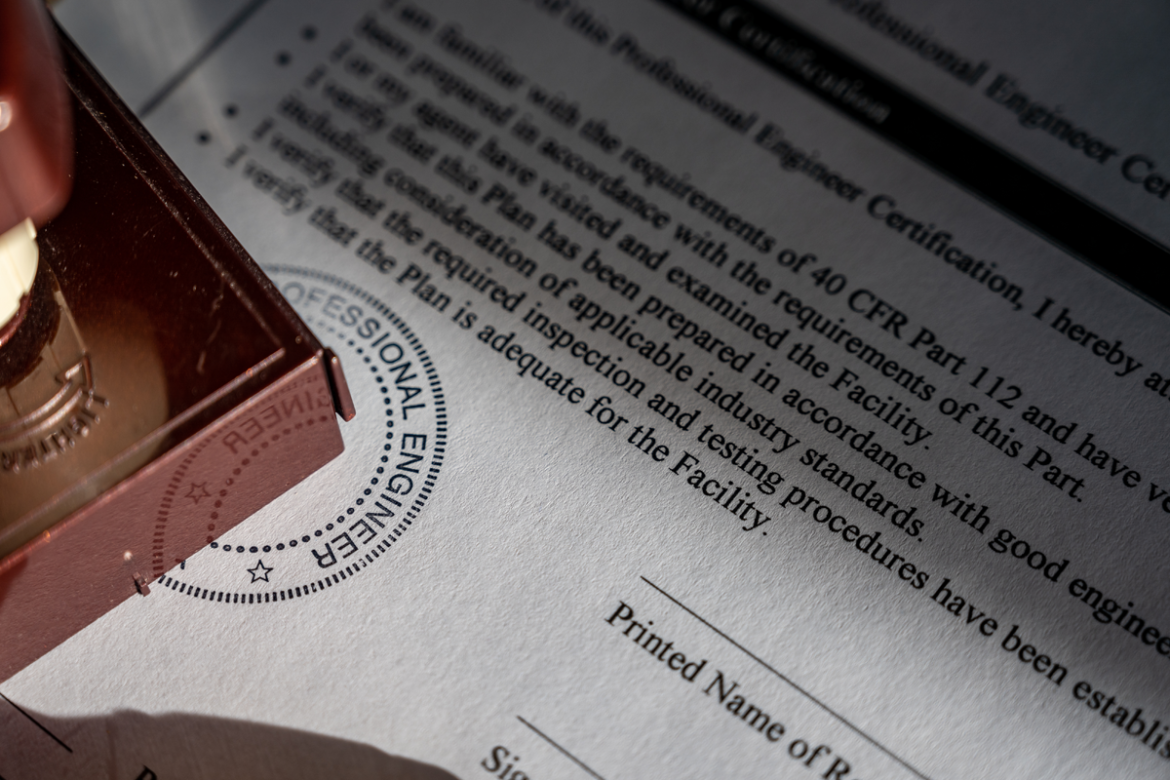
What Does an Engineer’s Stamp or Seal Really Mean?
Sarah A. Johnson, Esq.
If a group of engineers were polled regarding what it means to stamp or seal plans and drawings, the common response would hopefully be the same—the engineer stamping or signing the plans and drawings is in responsible charge of and/or has direct supervision over the work contained in those plans and drawings. The licensing laws of the various states typically require the engineer stamping the plans or drawings be in “responsible charge” of or have “direct supervision” over the work depicted in the plans and drawings.1 Although defined with slight variations in every jurisdiction, the phrases “responsible charge” and “direct supervision” generally mean the engineer must have independent control and direction of the engineering work and control over and detailed professional knowledge of work prepared under the engineer’s supervision.2 Some state regulations outline express tests that can be applied to determine whether an engineer is in “responsible charge” or has “direct supervision.”3
Most engineers understand the ethical and licensing implications in signing and/or sealing plans or drawings. However, engineers should also recognize the liability implications as well. Many of the state statutes and regulations specifically state that the term “responsible charge” does not refer to the concept of financial liability.4 However, these statutes and regulations contain other, often conflicting language suggesting that the signing and/or stamping of drawings may significantly impact the engineer’s potential liability; e.g., the engineer “shall take all professional and legal responsibility for documents signed and sealed under his/her responsible charge.”5
It is not uncommon for engineers to provide a limited scope of services on a given project. When this occurs, an engineer should be wary of signing and/or sealing plans, drawings, or work product that incorporates the work of others. In these cases, a claimant may argue that the act of signing and/or sealing the plans, drawings, or work product makes the engineer liable for any deficiencies in the plans, drawings, or work product. Language pulled from the statutes and regulations regarding professional signs and seals can be used to argue that the engineer is responsible for every aspect of the work product they sign or seal.6 Further, statutory and regulatory language can be used to argue that an engineer must be knowledgeable of the entire project and has a duty to make sure the overall structure is sufficient for its intended use by virtue of signing and sealing the plans and/or drawings.7 The statutory and regulatory schemes of some states provide options for specifically detailing the limitations of the engineer’s services or indicating the work is the result of multiple licensed engineers on the plans, drawings, or work product that the engineer signs or stamps. However, other states do not.8
Engineers should proceed with extreme caution when asked to sign or seal plans or drawings if they are only responsible for providing a limited scope of services. The act of signing and/or sealing plans, drawings, or work product that incorporates the work of others may not only be a violation of licensing law, but also may subject them to liability, or accusations of such, for work they were not contracted to perform.
CITATIONS
1 Cal. Bus. & Prof. Code § 6735 (Dearing 2021); Colo. Rev. Stat. § 12-120-216 (2021); 68 IL Admin. Code § 1380.300(b)(2) (2021); 250 Mass. Code Regs. 5.03 (2021); Ohio Admin. Code § 4733-35-07 (2021); Texas Admin. Code § 137.33(a) (2021).
2 Cal. Bus. & Prof. Code § 6703; Colo. Rev. Stat. § 12-120-202(8); 225 Ill. Comp. Stat. Ann. 325/4(f); 250 Mass. Code Regs. 5.04; Texas Admin. Code § 131.2(11)
3 4 Colo. Code Regs. § 730-1.2B.14.c. (2021) (“As a test to evaluate whether an engineer is in responsible charge the following must be considered: An engineer who signs and seals engineering documents in responsible charge must be capable of answering questions as to the engineering decisions made during the engineer’s work on the project in sufficient detail as to leave little doubt as to the engineer’s proficiency for the work performed. It is not necessary to defend decisions as in an adversarial situation, but only to demonstrate that the engineer in responsible charge made them and possessed sufficient knowledge of the project to make them. Examples of questions to be answered by the engineer could relate to criteria for design, methods of analysis, selection of materials and systems, economics of alternate solutions, and environmental considerations. The individual should be able to clearly define the degree of control and how it was exercised and be able to demonstrate that the engineer was answerable within said degree of control necessary for the engineering work done.”); Fla. Admin. Code Ann. r. 61G15-18.011(1)(c) (2021) (“As a test to evaluate whether an engineer is the Engineer of Record the following shall be considered: (1) The engineer shall be capable of answering questions relevant to the engineering decisions made during the engineer’s work on the project, in sufficient detail as to leave little doubt as to the engineer’s proficiency for the work performed and involvement in said work. It is not necessary to defend decisions as in an adversarial situation, but only to demonstrate that the engineer in responsible charge made them and possessed sufficient knowledge of the project to make them. […] 2. The engineer shall be completely in charge of, and satisfied with, the engineering aspects of the project. 3. The engineer shall have the ability to review design work at any time during the development of the project and shall be available to exercise judgment in reviewing these documents. 4. The engineer shall have personal knowledge of the technical abilities of the technical personnel doing the work and be satisfied these capabilities are sufficient for performance of the work.”).
4 Cal. Bus. & Prof. Code § 6703; 4 Colo. Code Regs. § 730-1.2B.14.d.
5 4 Colo. Code Regs § 730-1.2B.14.e; see also Tex. Admin Code. § 137.33(a) (the purpose of the seal is to assure the use of the engineer’s product and that the work had been performed or directly supervised by the professional engineer named, as well as to delineate the scope of the engineer’s work.”).
6 E.g., 4 Colo. Code Regs § 730-1.2B14.c (stating that the engineer must possess sufficient knowledge of the project to make decisions as to criteria for design, methods of analysis, selection of materials and systems, economics of alternate solutions, and environmental considerations).
7 Navarro v. Flowers Baking Co. of El Paso, LLC, 389 S.W.3d 475, 480-81 (Tex. Ct. App. 2012) (citing Tex. Admin. Code § 137.33 (b)) (finding that an engineer’s liability is tied to the sealing of engineering documents); William H. Gordon Assocs., Inc. v. Heritage Fellowship, 784 S.E.2d 265, 274-75 (Va. 2016) (citing 18 Va. Admin. Code § 10-20-760) (rejecting the civil engineer’s argument that it could not be held liable where it relied on and incorporated information from a manufacturer in the plans that the engineer sealed).
8 4 Colo. Code Regs § 730-1.5A.5; 250 Mass. Code Regs. 5.03(12)-(13); Tex. Admin. Code § 137-.33(g).






